How Attachment Theory & Reprogramming Your Subconscious Beliefs Will Change Your Life W/ Thais Gibson
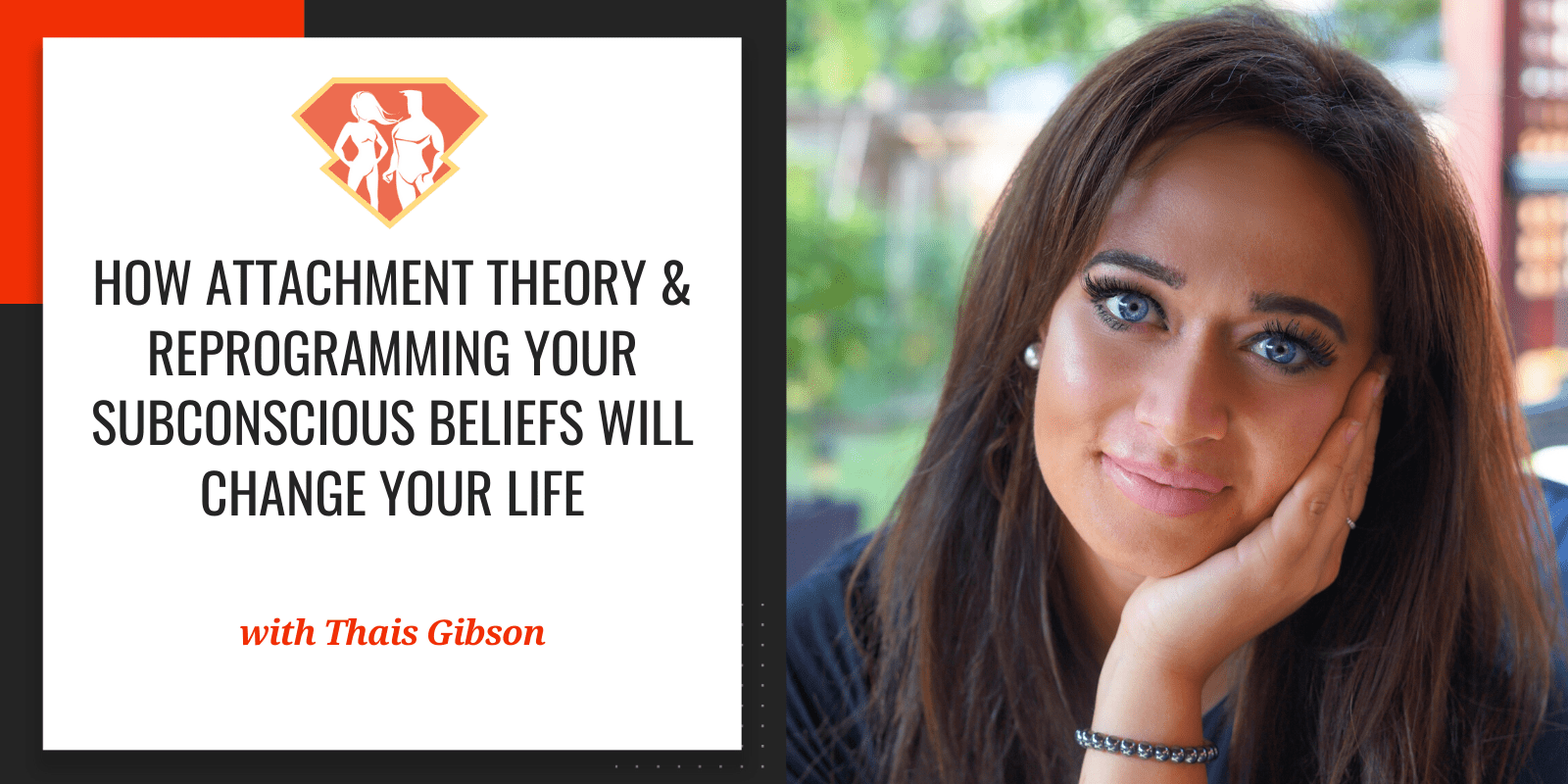
Greetings, SuperFriends!
Today we are joined by Thais Gibson. Thais is an author, speaker, and co-creator of the Personal Development School. She is, as you will see, extremely passionate about personal development and growth, specifically around the subconscious mind. She has an MA and 13 different certifications ranging from CBT to hypnosis, and in this episode, we covered a lot of them and learned about what Thais is probably most known for, which is her work and contributing research on attachment theory.
Now, this isn't something that we've talked about on the show before, but it's something that has dramatically impacted my life. I read a book on attachment theory years and years ago, and it changed the trajectory of my life because it changed the way that I was going about looking for a healthy and happy relationship – something that I hope for each and every one of you in the audience.
So we talk about that. We talk about how to understand where you are, the basics of the theory, and how it impacts you and your relationships. And then we got into another cool topic that we don't cover a lot on the show, which is hypnotherapy.
Is it the real deal and how does it work? Why does it work? So I did not talk a lot in this episode. Thais is very passionate, knows what she is talking about, and so I just sit back and let her share knowledge bomb after knowledge bomb. I think you're really going to enjoy this episode.
-Jonathan Levi

This episode is brought to you by BluBlox. Click here to save 15% on their amazing blue-blocking glasses, for all orders placed on their website, by adding coupon code SUPERHUMAN at checkout!
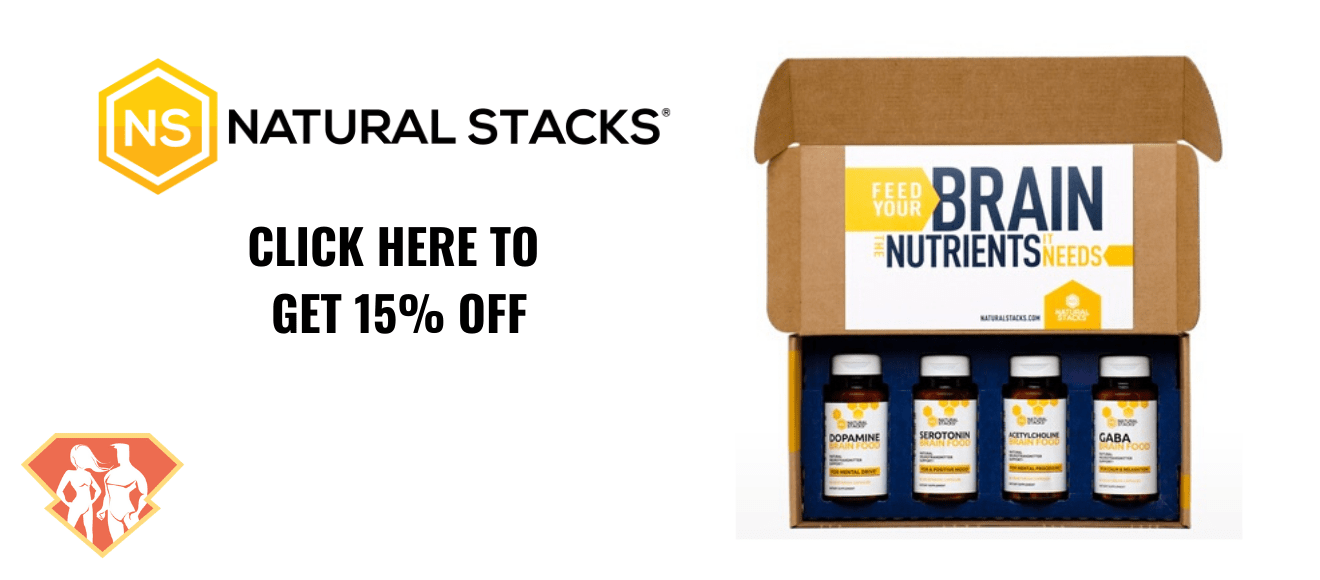
This episode is brought to you by Natural Stacks. Click here to save 15% on their Premium Supplements for a Better Brain, for all orders placed on their website, by adding coupon code SUPERHUMAN at checkout!
In this episode, we discuss:
- Who is Thais Gibson, what does she do, and how did she get here? [4:15]
- Attachment theory and different types of attachment [8:00]
- Can we change our attachment style? [11:30]
- Do you need another person to work with if you want to change your attachment style? [13:55]
- How can we identify our attachment style? [15:45]
- What does it require to have a healthy, secure relationship? [24:40]
- Do common self-improvement techniques help with our attachment style? [26:40]
- What is some homework you can do on attachment? [31:00]
- What is hypnotherapy, and how does it work? [34:30]
- Where can you learn more about Thais Gibson? [45:45]
- Thais Gibson's final takeaway message [46:35]
Resources Mentioned in This Episode:
- Personal Development School
- Attachment Theory: A Guide to Strengthening the Relationships in Your Life by Thais Gibson
- Attached by Amir Levine and Rachel S. F. Heller
- Personal Development School on YouTube
- Personal Development School on Instagram
Favorite Quotes from Thais Gibson:
Transcript:
Welcome to the award-winning SuperHuman Academy podcast where we interview extraordinary people to give you the skills and strategies to overcome the impossible. And now here’s your host, Jonathan Levi.
Jonathan Levi: This episode is brought to you by BLUBlox. Blue and green light is destroying our sleep hormones and performance, and that's why it's important to wear blue light blocking glasses. But did you know that all blue light glasses aren't created equal? I personally have started wearing BLUBlox blue light blocking glasses as they are the only blue light blocking company in the world that create Evidence-Backed Lenses for filtering blue and green light.
Their Australian lab built lens technology is fitting into the most fashionable frames and they even can make prescription and reading glasses in their optics lab. So whether you want to wear their Sleep+ glasses that block 100% of blue and green light, their SummerGLO “mood booster” glasses, or their BluLite computer glasses that don't have a yellow tint, BLUBlox has you covered.
I wear the Sleep+ glasses two to three hours before bed and my sleep has never been better, and I feel so well rested. The daytime ones are also great at reducing digital eye strain, headaches, and lowering stress.
With free and fast worldwide shipping using code SUPERHUMAN at checkout, now is an amazing time to level up your sleep and eye health. Just go to BLUBlox.com, that's B-L-U-B-L-O-X dot com and enter code SUPERHUMAN to save 15%.
Greetings, SuperFriends! And welcome, welcome to this week's episode, which I don't actually have a review to read out on air. So if you haven't left one yet, we would really, really appreciate it. I know there are still many more of you out there who have not left reviews, so please take the time to go ahead and do it.
Ladies and gents today we are joined by Thais Gibson. She’s an author, speaker, and co-creator of the Personal Development School. She is, as you will see, extremely passionate about personal development and growth, specifically around the subconscious mind. She has an MA and 13 different certifications ranging from CBT to hypnosis, and in this episode, we covered a lot of them and learned about what Thais is probably most known for, which is her work and contributing research on attachment theory.
Now, this isn't something that we've talked about on the show before, but it's something that has dramatically impacted my life. I read a book on attachment theory years and years ago, and it changed the trajectory of my life because it changed the way that I was going about looking for a healthy and happy relationship – something that I hope for each and every one of you in the audience.
So we talk about that. We talk about how to understand where you are, the basics of the theory, and how it impacts you and your relationships. And then we got into another cool topic that we don't cover a lot on the show, which is hypnotherapy, actually understanding if it is the real deal and how does it work? Why does it work? So I did not talk a lot in this episode. Thais is very passionate, knows what she is talking about, so I just sit back and let her share knowledge bomb after knowledge bomb. I think you're really going to enjoy this episode. This is almost the last you'll hear of me, and I think that's a really good thing because you don't tune in to hear from me every week.
So without any further ado, Thais Gibson…
Thais Gibson, how are you, my friend? Welcome to the show.
Thais Gibson: I'm wonderful. Thank you for having me excited to be here. How are you doing?
Jonathan Levi: Uh, doing really, really well. Uh, I went outside today. We're recording this in April, middle of April. I went outside today. Don't tell the authorities. It was wonderful. I went for a run, so pretty excited and pumped up for this conversation.
That's
Thais Gibson: amazing. I've been trying to get outside a little bit too and just keep my safe distance, but by the time not to be outside.
Jonathan Levi: Totally, totally. So taste. I did a little on the intro, just talking about you, but with 13 different certifications, I feel like I should ask you to kind of present who you are and what you do, and also your superhero origin story, how you got into all of
Thais Gibson: this.
Yeah, thank you. So, um, a little bit about myself. So I grew up in and was really into sports, got a D one soccer scholarship to play in, in the U S I'm originally from Canada and had some, uh, crazy sports injuries, knee surgery, all that good stuff, and actually got addicted to. Painkillers. And, um, and that was really young for me.
And I think there are a lot of sort of underlying childhood traumas. I hadn't resolved sort of at the subconscious level and a lot of things I was carrying that I didn't understand. And so I went through depression, anxiety, inpatient rehab, outpatient rehab, sort of went through the whole run of the mill in that area.
And really wanted to like get better and heal and figure things out. But I just, I always felt like I was in this war against myself, like wanting to get off painkillers, wanting to change my life and always kind of losing to myself. And what I later learned and realized was that that was the war between my conscious mind and my subconscious mind.
And it's so funny because we see people set like new year's resolutions or goals and not follow through. And. Basically, unless we're targeting things at the subconscious level and repatterning at the subconscious level, it's very difficult to change. The subconscious mind will always win against the conscious mind in the end, essentially.
And so that was a huge thing for me. And as somebody who was very hardworking and like really sports driven and sort of that like athlete mentality, I kind of channeled that once I started getting my hands on the right resources and tools. To, um, personal growth and understanding. And so I ended up doing a master's degree and then a whole 13 different certifications and you name it and maybe got like a little bit addicted to learning about the mind and growth and how things, how things work.
But it was such a beautiful, powerful journey for me. And, um, and that led me into practice with clients. Um, as soon as I started a practice, I was really blessed to have like a wait list for a year after, you know, being like a month or two in and, um, And then started teaching classes and helping psychologists, psychiatrists do some of their training and their work and sort of target things differently.
And then that led to an online business and then putting together the personal development school, which has over 25 different courses. I've written in a whole bunch of different things from depression, anxiety, addiction, to like life mapping, attachment styles, and attachment trauma, conflict resolution, all sorts of different things that are basically tools that you need.
For life and to go through life and everything in our school is targeted at the subconscious level. So basically my, my story was how to really create change when you have this conscious goal in mind. And you're like, please, like, I want this to end. I want this to stop and then realizing, okay, we need some form of cognitive resonance between the conscious and subconscious to do so.
And I'm my mission is to bring that to people and to help people be able to change and transform specifically by understanding what's going on beneath the surface.
Jonathan Levi: Incredible. Give me a sampling of some of these 13 certifications, just this jumping off points for the rest of the conversation.
Thais Gibson: Yeah. So, um, I did a whole bunch of stuff.
So cognitive behavioral therapy, neuro linguistic programming, hypnosis, um, internal family systems, also so many different things. Um, but those were probably my favorites. I would say in terms of, and somatic experiencing, too, I would say is, is in the top five because, um, it really impacts like how we use our body and how the body stores trauma and emotional memories and how to really link the two.
So I would say those are the top five. Really,
Jonathan Levi: really cool. And I understand you also did a lot of work on attachment theory, which caught my eye. Uh, attachment theory has been so fascinating for me and so beneficial in my life and helped me recognize that my wife to be was in fact, my wife to be, tell me a little bit about your involvement in attachment
Thais Gibson: theory.
Well, um, yeah, so attachment theory was really fascinating for me. So those top five has a lot to do with like the subconscious and reprogramming that area and linking those two. But I did a lot of work, obviously in attachment theory and that sort of, um, what I, I just finished writing a book on it and it's been published and, and essentially our attachment.
Traumas, like we all go through some form of attachment trauma because we're classically conditioned, right? So we're socialized and, and we're basically given the message through classical conditioning, through the punishment reward system that love is conditional and for little children who come into the world as unconditionally loving beings, that doesn't really bode well, like that teaches us to repress parts of ourselves and to really work hard to gain approval and that sort of approval seeking it gets.
Yeah. Deeply wired into our subconscious and then the rules through which we relate to others. And so we all go through different attachment traumas, but it's sort of been isolated into three main components. Like we have our secure individuals who go through less and then we have three different types of insecure attachment styles, and those are anxious, preoccupied.
Fearful avoidant, which is also sometimes referred to as disorganized attachment style or anxious avoidant. And then we have dismissive appointed and each different set of attachment cells has a pattern, a set of patterns that they learn to relate to with and through others. And so, for example, if you are a child and you've got a lot of inconsistency in parenting where parents are really emotionally available, but maybe they're working a lot, there's a lot of sort of touch and go then that young individual.
Learns that, Oh my gosh. I feel like I could be abandoned at any time. Like my parents are there, they're available, but then they're gone all the time. And these early rules are the exact rules we then use and apply in our adult romantic relationships. We fear abandonment and we fear loss with your being alone.
And then the same goes for the other end of the attachment spectrum. Which is your dismissed of avoidance. And these are the individuals who learn that they basically need to self-sooth they're not really given a lot of emotional connection and depth and, and they're not really attuned to, so they're not, you know, if they cry or they express emotion, it doesn't really go well for them.
They often get rejected or dismissed. And so long term, these individuals learn, okay. I'm kind of out for myself. I have to self sooth and. They don't understand this need for like deep connection from others, because for them, their earliest subconscious associations in childhood were that that didn't feel safe.
That didn't work out well. And so we get these rules and then you imagine we have like one person who's maybe very dismissive avoidance. And another person who is married, maybe very anxious. And you can imagine the friction that could create an, a relationship together where one person needs the other person and the other person really needs their space.
And so these and these are usually the people we attract and relationships are of opposite attachment style. So you can imagine the impact that this has. And I would say after doing a ton of work in attachment theory and specifically targeting it at the subconscious level, this is probably the single, like the number one factor that impacts.
Whether our romantic relationships succeed or not.
Jonathan Levi: Yeah. It's been so fascinating to me as a journey. And, and basically the idea, I don't know if you mentioned this and I missed it, but the idea is it's fixed. It's you developed with this and you have this attachment style. Is there anything we can do to change our attachment style?
Thais Gibson: Absolutely. Like, so this is, you know, I don't want to. Go on a tangent too much, but this is sort of one of my, you know, challenges with, especially myself, I grew up in was trained in the Western healthcare system. And, and, you know, the Western healthcare system likes to target things at the conscious level like, Oh, these are the patterns you're stuck with them, but really what's happened is that in childhood, you got a certain set of patterns that you learned, you weren't born with these things, and these things became wired and, and sort of hardwired into the subconscious mind over time.
And then you see the world through that process. Perceptual filter of relating. And so we can target this at the subconscious level and completely transform it. I, myself was very fearful avoidant, um, had the very fearful of what and upbringing and characteristics. And I've been in a very longterm relationship now with somebody who's very dismissive avoidant by nature, and we've worked on our attachment styles and leads to different things.
And I would say we are both very secure and I've personally worked with probably hundreds. Maybe close to a thousand or more people and workshops and one-to-one sessions over the years. And there has been a tremendous amount of individuals who have transformed their attachment style completely. So we have to learn a new set of rules.
We have to learn a new set of patterns, like how to communicate, how to emotionally regulate, how to express our feelings and needs and learn that. The state of vulnerability, how to be present with others. And if we can do these specific things, there's a few others, but if we can do these specific things, not tell stories to ourselves, not make up narratives about somebody's behavior and then personalize it.
If we can break through some of these patterns that are creating those insecure habits in the ways that we relate and our attachment style is completely reprogrammable. As long as we are. Reinforcing these things through repetition and emotion over time, which are basically two necessary ingredients to reprogram the subconscious mind.
Jonathan Levi: Incredible because I remember reading attached and kind of the last few pages of the book was like, you know, your attachment style is fixed and everyone should be with a secure attachment style. But the good news is there are a lot of secure attachments out there, uh, which was my, by the way, that was the cure for me.
I married a secure attachment style and, and everything's been wonderful and I've become so much more secure. By osmosis, but you're saying you actually don't even need, you did mention that you and your partner worked together. So do you need another person to work with and develop those new patterns?
Or is this something you can do on your own?
Thais Gibson: I love that you raised this point because you just mentioned like you were with somebody secure and then you became more secure over time. And, and, you know, you can imagine that if you, and obviously this is your, your wife to be in congratulations, but you can imagine in theory, if you were to be with somebody else, now you have over time learned through her through repetition.
Plus the emotional reinforcement. You've learned different patterns of relating that eventually. Oh, again, over time through that repetition piece, get programmed into your subconscious. So if you, you would be different from this point forward in any new relationship you entered into because of the fact that you've had these new patterns reinforced, you might still have old tendencies and things come up that you could work through, but I just, yeah.
You know, doesn't that, and the way that even the book attached, highlights it and says, you know, I'm always be with a secure person. This is how you change. Well, what that's telling you is that you can change over time through learning new avenues of relating. So we can do that on our own and, and with work and with understanding and with awareness and, you know, we've got Hunter.
Just under a thousand students in our community. And, um, you know, they're having amazing results and transformation because they're showing up and they're doing the work and applying themselves. And so we're seeing all the time people saying I'm secure in my relationships now. And we launched the school six months ago, just under six months ago.
So it is absolutely possible to change. And, and I want to just make sure that when people get that message it's fixed, it's fixed in the, in the sense that it's fixed into your subconscious. It is wired in there, but we have neuroplasticity and neurogenesis and all these different things. And so all of these things are changeable and transformable.
If we get the proper tools and awareness.
Jonathan Levi: Fantastic. I would love if you could share, um, And I, I know we're on, we're on like a mega tangent, but I know you're very well known for your work and attachment theory. I'd love if you could share, like how can people identify which one they are and if this is an area where they need to maybe do a little bit of self work,
Thais Gibson: Absolutely.
No, I love this as a great tangent. I enjoy talking about this stuff maybe the most. So, um, so, uh, number one, we actually have an attachment theory quiz at the personal development school. Um, and it's right on our homepage there. So it's easy to access. You can take a quiz, but here are the, if you're just listening to this, here are the core, um, qualities that you'll see at the different attachment style.
So I'm going to sort of map this picture out. So imagine you're a child and research. Has proven that we essentially get our early subset of attachment patterns between the ages of zero to two years old, which is quite young, but it's those very initial imprints of how we learn to relate to others. So these things can change over time.
We see all the time people can be secure for example, and have secure parents. And then maybe there's a loss in the family, or somebody becomes an addict or there's a divorce or something is taking place. And then that person, even at eight, nine, 10, 15 years old transforms into an insecure attachment. So, again, it sort of begs the question.
If it can transform in a negative way, obviously we can change it in a positive way. And so if you imagine that this young child who has to secure parents, those parents, one of the first qualities that they need is attunement. So they need like when they cry, the parent shows up when they express a need, as they get a little bit older, that need is even if it can't be met, it's at least seen, heard, understood, validated to a certain degree.
It's not dismissed, rejected shames. Any of that. So one of the really core qualities of secure is that you learn that, Oh, my needs are worthy of being met. My emotions are worthy of being expressed. It's safe to do so. And as a result, you build self confidence in you to the same degree and you learn to hold space for others in the same way.
So if we use that as sort of a model to then look at the insecure attachment styles, and we look at dismissive avoidant, Fearful avoidant and anxious, preoccupied, what the anxious individuals here, some of the core qualities that you'll see for anxious individuals, number one, you'll see that they deeply fear abandonment and loss.
And because of a lot of this inconsistency in childhood, or even in later relationships, somebody can be secure and then be in a 15, 20 year marriage with somebody let's say very dismissive and become as a result, a lot more anxious and develop these sort of anxious edges around their attachment style.
So again, these things are all. When we look at, um, the anxious individual, they tend to fear abandonment, fear, loss, fear, rejection. They tend to have certain core wounds. I noticed at the subconscious level, these sort of like beliefs and stories, they're caring about themselves. And these are things like I'm not good enough.
I'm unworthy. I might lose love or love is easy to lose or I'm unlovable even. And they tend to have these deep fears and. Basically assumptions that they will be rejected in time. And as a result of this, they become hypervigilant around these things. And what this creates is this output of stories.
That's really easy because the, to tell, because the brain loves to fill in the blanks. So for example, let's say you have an anxious person and their partner comes home and it's cold or a little bit shut off because they had a really long day at work. Maybe they had a tough. Day, you know, the anxious person is less likely to be able to see, Oh, maybe they're going through something.
And their brain is more likely to jump to these conclusions based on these internal stories, they're already caring about themselves. Like I'm about to be rejected. This person's falling out of love with me. I'm not good enough. I did something wrong. I'm unsafe, something bad is going to happen. And so they fill in these blanks based on these early core wounds that they've experienced.
So that's your anxious. And you'll see the anxious have behaviors that are like becoming clingy when they feel afraid. Sometimes calling repetitively, not respecting boundaries that somebody, um, communicated because they're desperate to feel safe and get that connection. And the marker of the anxious preoccupied is that they tend to have difficulty self soothing.
So that's at one end of the spectrum. And then we have our dismissive at the other end and the dismissive, again, as we were mentioning earlier, they tend to, to have some form of emotional neglect and childhood and. Often, what I've found in working with so many people is that dismissive often, um, have emotional neglect that flew under the radar.
Like the parents were great at showing up for the physical needs. And, um, we're good at, you know, being supportive in terms of, you know, education, your belongings, a safe household, but there wasn't this like, Emotional connection or bond. And there wasn't a space usually because one or more of the parents was dismissive themselves.
There wasn't a space to feel safe, communicating your feelings, expressing emotion, these sorts of things. And that can happen for a number of different reasons. But what we see in the dismissive is when you're looking for qualities to identify, it's usually that the dismissive tend to be a little bit cold.
They're a little bit slow to warm up. They can be sort of charming and have that nice quality to them. But there's this wall that you might feel like you're heading with this individual because they haven't had that deeper attunement. So they're not really, they haven't had this opportunity to learn how to attune to others naturally because that wasn't shown for them.
And that wasn't learned. So dismisses can be a little bit cold, a little bit slow to warm up. They dislike vulnerability very much. Um, anything that requires too much vulnerability at any point in time, they usually feel shame around and they'll get sort of the shame hangovers if they overexpress or anything like that.
But it's something that they rarely, rarely do. Anyways, dismissing avoidance tend to fear commitment. They tend to, when somebody comes really close and gets very close to them, they tend to naturally pull away. And, you know, over the years I've discovered that this is something that really happens at like the nervous system level.
There's a natural shutting down response and they feel that there's a high priority in their lives for things like safety, security control. Um, you know, they tend to be very focused on. You know, a relationship to them means like harmony safety, they don't like drama. They don't like fighting. And sometimes it can be a little bit conflict avoidant until they sort of hit a level where they can also burst after holding it in for quite some time.
So these are the people you'd see in your adult relationships that are, you know, afraid to commit, like to take their time, slow moving these sorts of things, and then are fearful avoidance. Right in the middle, um, are individuals who tended to experience a little bit of trauma in childhood to a certain degree.
So these would be things like a lot of fighting in the home violence in the home, maybe one or both parents struggled with addiction. And so the big marker here. Is that there's no attachment strategy for the fearful avoidant. You know, you look at the anxious and they're like I, so through others, you look at the dismissive and they're like, I see what on my own, the fearful of what it doesn't really learn either because they feel like they're always walking on eggshells in their home space.
So it's like, is mom going to be nice today? She's going to be mean today. Is dad going to be this way or this way? And they tend to have this pattern with their caregivers where they never really know what's going on. So they develop this extreme hypervigilance. And they have their anxious side because sometimes the caregivers are nice and warm and loving, and they have this dismissive side because oftentimes the caregivers are exactly the opposite and emotionally, very unavailable and even hurtful.
And so one of the big markers for the fearful avoidant is that they oscillate so much between their anxious side and their dismissive side, and a big distinguishing factor is they generally struggle to trust more than any other attachment style because they didn't have. Some form of consistency. Like they didn't get rules, if that makes sense.
So it dismissive is like, I can't trust. I can trust myself. The anxious is like, I. You know, and so you see like the fearful of white doesn't have rules in that space. So they tend to have the anxious, wounds and fears, like fear of abandonment, fear of loss, all these different things. And they tend to have this fear of being trapped, stuck, needing their independence, needing their space.
And they can be quite difficult in relationships, obviously as a result because you'll get this hot cold partner all the time. And I find historically that most individuals, when they're going through a breakup. Or even like starting into a relationship, there's almost this addictive quality to people who are dating the fearful avoidant, because it's like intermittent reinforcement.
It's like gambling, right? It's like you get, you get the warm, you know, prize one day and then you get the cold disrupted sort of pulled back person the other day. And it also leads a lot more quickly. So I know that was a lot of details, but I find that it's important to like really put all the details out there so people can hear like, Oh, that's definitely me or, Oh, that's definitely my partner.
And, um, and the secure obviously is it's usually balanced and poised and communicate their needs and feelings and, and generally shows up consistently in the relationship dynamic.
Jonathan Levi: Yeah. And I guess the, the end sum game is we all for our own wellbeing, but also the wellbeing of our relationships. We all want to move towards being a more secure, right.
Having more trust, having more communication, having more vulnerability, like that's where the magic is. Right.
Thais Gibson: Absolutely big time. And so, you know, it really requires consistency. It requires, I think relationships. And one of the powerful things that relationships do for us is they force us to look at ourselves.
Like they force us to see what's not working inside of us. And if we can get out of this habit that obviously I think society conditions into us to a certain degree, if we can get out of this habit of like, Oh, you're making me feel this way. Or, you know, really we can look at our emotions are our responsibility to deal with.
And if we can look at them as feedback mechanisms to go, Oh my goodness, I'm struggling with feeling anxious or I'm struggling with feeling distrustful. Or, and if we can look at those things and be like, what inside of me is, co-creating that pattern and how can I take responsibility for that? How can I look at the roots of this?
Like where did this come from and why is this. Prevalent in my relationship dynamic. If you can look at those things from that perspective, relationships are amazing opportunities to heal and grow.
Jonathan Levi: Alright, at this point I want to take a quick break to let you know about an awesome deal that we've worked out with this episode's sponsor – Natural Stacks. Natural stacks is the maker of a series of all natural, transparent lab tested and verified formulas that are proven to help you alter your state of mind and your brain chemistry for the better. Whether that means improving your focus, improving your mental clarity, improving your mood, or just improving your sleep. They have a product for whatever state of mind you want to be in and you can get there naturally and safely.
Now, some of the products I recommend you check out are their Serotonin Brain Food™, their MagTech® Magnesium Complex Supplement, or their Neuro Fuel all natural nootropic. Now to take advantage of this awesome discount, all you need to do is visit naturalstacks.com/superhuman that's naturalstacks.com/superhuman.
Alright, let's get back to the episode.
Now. I want to ask him, yeah, it's very clear to me that there is specific work that can be done for this. We talked about, you know, getting into a healthy relationship with a secure attachment style is being one of the best ways.
Part of me wonders. Along the journey of personal development, right? Like things like I'll just throw out a bunch of different stuff. Right. But meditation, uh, cognitive behavioral therapy, um, journaling, like all these different things that are supposed to help us understand ourselves better. Do those have an effect in our attachment style or is it really the case that we need to do focused work on this specifically?
Thais Gibson: That's a beautiful question. So really what I found is that some of those things you mentioned are definitely standpoint. So what I found is that one of the first things we need to do to transform our attachment style is transform the stories and the core beliefs that we carry about both ourselves.
And about other people. So if we can change that, I'm going to be abandoned. I'm going to be alone forever. I'm going to be trapped powerless. If we can change these core wounds, that different attachment styles, carry and isolate what those are for us specifically. And we can work to reprogram them and change the story and use that repetitively over time to see how you're actually not alone.
And you will find connection and you're capable and all these different things that we can change those stories and really question that internal dialogue that consistently runs. In our, in our mind all day, because we're carrying those core beliefs, then that's a huge beginning step. And then our second step is to start changing the stories we tell about other people.
I can't trust people. People are going to abandon me all these painful things because belief, patterns and imprints, we collect over time in the subconscious create an output of thoughts. Thoughts create an output of emotions and then this tends to reinforce itself. So if you look at it too, like our emotions are made up of neurochemical reactions.
So our attachment traumas can literally play a role in impacting the way we feel all day long. And, um, our neurochemical. Balance or imbalance like our neurochemistry itself. So when we can start changing the stories at the root level, the belief level and challenge these things, that's a huge first step.
And then there are some other really important steps that are necessary, and these are things like communicating your needs. Understanding what those needs are in the first place so that you can communicate them. A lot of people don't even know what their needs are in relationships I've found and learning about vulnerability, learning to be present, learning, to validate other people's emotions, but not their behavior.
You know, the emotional validation is such an important piece of connecting with others. We can have a disagreement. And some kind of fight, but you know, if I just blame you in that situation, I say, Oh, but you should've never thrown that vein as you what's wrong with you, you know, that doesn't do anything for mounting connection.
Right. But if I can say, Hey, you know, I saw you were in so much pain when you did that. The behavior is completely not acceptable, but like what was going on inside of you that led up to that. And if we can start being vulnerable and communicating that way, that completely changes our ability to resolve conflict between people.
And so it's really like, can we do these things? Can we change our stories? Can we emotionally regulate as a result, can we express our needs and understand what they are? Can we be present and start to understand each other's emotions and validate those things? And if we get those core qualities, there's a whole bunch of other smaller nuance pieces.
But if we get those core qualities, we are well on our way. And so, as you mentioned, things like journaling and meditation, that's, they're useful because it connects us to ourselves. Meditation is a great way to start regulating because what does meditation teach you to do? It teaches you to observe yourself your patterns.
Your thoughts, your stories, right? All these different pieces. And it also helps you to start regulating and being more connected to yourself as the observer, which is so important. It's a very important piece of emotional regulation as a whole. And then things like journaling it's self-connection, and that's one of the most important things that somebody who's anxious can do because they've been out of relationship to themselves for so long.
And so when they can get in a relationship to themselves, when they can start. Understanding what they're feeling and needing in real time, then they start building this capacity to self sooth. And so a lot of those are amazing tools. That's entry points, but those it's the five sort of deeper pieces under there about needs and stories and belief patterns that tend to be the cornerstones of how we reprogram our attachment style as a whole.
Jonathan Levi: Really cool. Really cool. I think that's so valuable. Is there a piece of homework around attachment styles, maybe an exercise or an article, something that people can do in the next week, uh, as they wait for the next episode to act on that and take a step towards, uh, maybe understanding or improving their attachment style.
Thais Gibson: Absolutely. So one of the biggest pieces I have this tool inside the school and I push this a lot everywhere. Cause I think it helps in all areas. So we know. That the two things that are impacting us emotionally, literally the only two things that impact us emotionally are painful stories that we're telling ourselves based on those beliefs and thought patterns, because we're our emotions are feedback mechanisms.
They're letting us know when something's out of alignment. Right. And it's always going to be one of these two things, those beliefs and thought processes. Or unmet needs and that's the beautiful, like our emotions are letting us know when we have needs on that, because that's helping us to evolve and grow.
Like if we didn't have pain, we wouldn't ever evolve and grow. So, so our emotions are helping us see these things. So when we're struggling and it doesn't matter what your attachment style is, it sort of applies to all of them when we're struggling. When, whenever we feel some kind of negative emotional output, we want to trace it in words and we want to be able to go, okay, what have I just been thinking about or believing, or like, what stories am I telling myself in this situation?
Or what meaning am I giving to the situation? And that's usually going to be based on some of those core beliefs. And then once we work through that meaning, so your first step, if you were to go through it and exact steps, let's say you're frustrated about something you're resentful to a partner. You're frustrated about something that happened at work that day, whatever it might be.
Start by identifying the emotion. So step one, identify the emotion. I can actually send you a worksheet if you want to post it as well. Step two. Trace that emotion and words and ask yourself, what meaning am I giving to the situation that's causing me pain? What am I making it mean about me? And about the other person that might be involved?
Step three is going to be to question those things because our brain loves to tell these one sided stories. It loves to say, I made a mistake at work and I'm going to lose my job and be out on the street. Right. And every single thought. That passes like that on autopilot or subconscious mind fields and emotionally respond to as if it's an absolute truth.
So we have that passing thought and now we're living in that reality where we're literally on the street. And so your emotions are like, hello, wake up, stop telling yourself these painful stories. So we have to question these stories and then once we've done that in very rare cases, the story will be completely true.
But usually the mind is really great about creating these sort of cognitive biases and distortions instead. So we question those and then we want to find underneath, okay, what is the unmet need in this situation? And what's a strategy to get that need met. And so it's these core five steps of using your emotions as feedback going in, and then disrupting those stories and then finding and strategizing for those needs.
It's like change your thinking, meet your needs, change your thinking, meet your needs. And if we can master just doing that, not only will that have a massive impact on our attachment style as a whole. But through repetition of doing that process over time, we start reprogramming all these patterns that were debilitating us in the beginning.
And this trend, this applies to our emotional wellbeing, depression, anxiety, but it especially applies to attachment trauma and the way we relate to others.
Jonathan Levi: Incredible. That's a really great one. And yeah, if you want to send over that worksheet, we can, we need their link it on your website so people can engage.
Just go ahead and send it. We'll put it in the show notes. I want to transition taste a little bit because I think it's a, it's a good time to talk about hypnotherapy, which you also have done a lot of work in. I know quite a bit about, we've never actually talked about hypnotherapy. On the show. I honestly used to think that it was like bunk and then a friend of mine went and got certified and like learned all about this stuff and it turns out it's actually not bunk.
So tell me a little bit about that.
Thais Gibson: So I, so I love this topic and I love this topic, obviously because it, it engages the subconscious mind. I, so I did my certification as a hypnotist years ago, and I actually stopped practicing hypnotherapy, um, a few years back. And what I did instead is I really took the principles of hypnosis and taught people how they can start essentially working these principles on themselves.
Because what I, what we know in traditional hypnotherapy is that it's extremely effective. Initially, but then it's up to the individual to provide themselves with something called post hypnotic suggestions and what those post hypnotic suggestions do. So let's say for example, that you're, let's pretend you're getting hypnotized and you're wanting to work on a fear of abandonment.
Okay. And, and let's say you're applying these things and you work through something in the actual session. Well, that has an emotional imprint that it creates on your subconscious and the emotion. The subconscious speaks a lot more through emotion than it does through language. So, so that's powerful. But then what we often would see is that a week later, two weeks later, these things start to creep back in again.
And so what's really important when we talk about hypnosis is that it's really powerful and it is a great way of accessing the subconscious because it's. Specific brain waves that your brain is producing and all these different patterns, but we need to understand the principles of what's working and what's going on so that we can then reinforce those neuro pathways.
And if we look at something called neuroplasticity, which I'm sure you're quite familiar with when we are trying to. Create new patterns. Our brain can change. Our brain can produce completely different neural pathways if we fire. And why are those things over time, especially if they're in replacement of an old pattern.
So let's say you look at how you have connection in your life instead of how you're going to have abandonment, then what's going to happen is over time that firing and wiring is going to. Take basically the it's going to substitute. It's going to be the new program to replace the old one and that old neuropathway when you're not using it anymore, or you're not firing and wiring it as often, that's going to atrophy over time.
And so, you know, hypnosis is amazing and it uses alpha theta, Delta, brainwaves, like very relaxed States of mind to be able to imprint the subconscious more effectively. And the more emotion is in there, the more of an impact it has, but. We also want to understand how our own subconscious is working on a day to day basis.
So we can use that pattern, those, those patterns and program ourselves, change our own thinking, change patterns in our own lives, in terms of our behaviors, even so that we can create new neural pathways for ourself intentionally. And this is something that I think. You know, most people are like, Oh, you need to be a trained hypnotherapist to do these things.
These are really simple tools. Like if we just have this awareness of what's going on inside of our minds and understand key principles of the subconscious, we can change our own neural pathways. We can create completely new paradigms for ourselves in terms of how we interact with and perceive our world.
Jonathan Levi: Incredible. Tell me a little bit more about how that looks like. How does that, how does that work? I imagine that's working with someone. Of course.
Thais Gibson: I see it. I love that. You said that it's um, that's traditionally what everybody's saying, right? That's the, Oh, you need to work with somebody one-on-one I absolutely think like if you're in a, you know, You're fearing that you're going to self harm or there's any like endangerment to yourself, please seek out a professional 100%.
But if you're looking to just transform your attachment style, you're looking to transform unhealthy relationship patterns you have in your life to food, to alcohol, to whatever it is, you know, as long as there's not this extreme, you know, potential for harm, um, we can do these things ourselves. So a couple of things you would want to know.
Is number one in order to change a problem, you have to very specifically isolate what it is. This is honestly where most people go wrong. First, first and foremost. So let's say, for example, you're like, Oh my gosh, I find myself binge eating food all the time, and I'm really trying to go to the gym, but I keep going back to binge-eating food.
What's happening first is that your conscious and your subconscious have different. Itineraries. Right. So your conscious mind is like, I'm going to go to the gym and this is why so many people fail their new year's resolutions, as I was saying earlier, because your conscious is like, I'm gonna exercise five days a week and your subconscious is like, no, we're going to really seek out security, comfort and emotional connection.
And so we first need to understand if we're trying to change something. If there's something we're struggling to change, it's because our subconscious isn't interested in changing it. Okay. So we need to figure out what that thing is. And then we need to understand what are the roots of this problem.
Okay. Why do I do what I do and what you'll find in asking yourself this question, is that everything that you do that goes against your conscious intentions is because there's some sort of need, you're getting that. So, for example, if you are the person, let's say it's Bob and Bob is trying to go to the gym five days a week.
And instead he's like, I'm just eating chocolate and going home right after work. Right. So, so if that's the case, then there's some kind of need Bob is getting met from. Eating the chocolate and skipping the gym. And it's something that his subconscious needs specifically. And so that's how we isolate the problem.
When we can ask ourselves, what needs am I getting that from this process? And Bob might find like, if we just look at our earliest subconscious associations to food, it's like your mother's breastmilk right. Which is. Security tons of oxytocin is produced in the breastfeeding process. And so it's emotional connections, it's security, comfort, emotional connection.
And these are the main associations that are around food. So you can look and go and it doesn't have to be that complex. Like you can just go, you know, food makes me feel comfortable. It's a pleasure. It's whatever it is. And then what you have to understand is that you want to be able to bring those things.
Into your life on a regular basis or through the desired activity you have. So how can you go to the gym and feel emotionally connected, maybe go to a group workout class, or you exercise with friends. How can you go to the gym and feel safe and comfortable? Maybe you exercise and cozy clothes at home.
So we want to first understand the relationship between what we're trying to do and why our subconscious is holding us back. And then what we can do is we can start looking at the stories we have that are blocking us. So for example, um, I feel not good enough to go to the gym. I feel too out of shape to go to the gym, whatever meaning we're giving, because that's the other part of what's blocking us.
It's always coming down to those two things. Your needs being on that or painful stories or caring about yourself. And then to reprogram those stories. What we want to be able to do is question that completely, and we want to be able to use repetition plus emotion. Like very consistently over time to create a new story for ourselves.
So if you're telling the story, I'm not good enough, where are you? Good enough. Where have you succeeded at other things you've set out for yourself? Where have you pushed yourself out of your comfort zone and felt great about it afterwards? And what you want to do is look for five or 10 pieces of emotional proof, and then to use like some tools around hypnosis when, when individuals are hypnotized, um, What's happening in their brain is they get into this very relaxed state.
And that relaxed state is when their mind is producing alpha brainwaves, but more so even theta and deep, deep States of hypnosis almost in the sleep space or our Delta brainwaves. And so if we can start questioning these stories, we have about ourselves telling ourselves a new story when our brain is most open to suggestion because it's producing those types of brainwaves.
We have a great capacity to change more quickly. And so the times that we're doing this are usually in the first hour, when you wake up, you're super suggestible, your brain is very open to suggestion. Cause it's mostly producing those alpha and beta brainwaves. You know, that feeling when you wake up, right.
And you're like, Oh, you're kind of peaceful and relaxed. And same with the last hour before we go to bed. But also times like in deep meditation, right after deep meditation, anytime somebody might be engaging in tools like breath work, um, after exercise, even during exercise, like if you're running your brain, when you get into that sort of runner's high space is, is starting to produce alpha brainwaves and relax a little bit and not think as quickly and think about all the things you have to do to the same degree.
So. Anytime we have these States, we are naturally very suggestible. And even when you see people, right, like watching television, for example, and you're like, Hey, like Bob, like pay attention and you're trying to talk to Bob, who's watching TV and he's in this like super trans and he can't turn around and pay attention.
He's actually in those States, television is also producing tremendous amounts of alpha and beta brain waves. We get into this like relaxed state so we can take those three components. And just start applying them to our everyday lives. We get tremendous power to start changing our own subconscious mind.
So again, alpha or beta brainwaves, those relaxed States, repetition and emotion. So we want to look for I'll just highlight one more thing in here. If, if I'm trying to change the story, if I'm not good enough. Okay. Sometimes we have people who are like, do affirmations, do all these things. The brain doesn't really care about affirmations to a certain degree because it speaks more through emotion than language.
So if I'm working on feeling good enough, and I have this deep story that I've carried for a very long time about how I'm not good enough when my brain is like, Doing affirmations and going, I am good enough. I am good enough if I don't emotionally believe that is at a subconscious level. My subconscious is going to emote the opposite.
It's going to emote feelings of not being good enough. And I'm actually going to do a little bit more harm than good, most likely. So what we need to do and how we bypass this is let's pretend that I come into an interview with you and I want to work for your company and. I'm saying to you, you know, you're like, okay, why are you qualified to work here?
I'm not going to go. Oh, because I'm good enough because I'm good enough because I'm good enough. I'm going to tell you specific pieces of proof because proof has emotions and coded in it. So if I say, Oh, I went to this school and I got these awards and I graduated in this space. And if I give you proof, that creates an emotional response.
And that's how we really engage that repetition plus emotion component. So when I'm trying to reprogram myself, I have to get in that translate state maybe right after a meditation. And I want to highlight really isolate that problem. Okay. It's a problem that I believe I'm not good enough. And then I want to create all these reasons to challenge that where I am.
Good enough. Maybe I look at all different seven areas of my life where I'm good enough. Where I've been good enough in the past when I've doubted myself and I need specific pieces of proof. And if I can do that on a daily basis for 21 days, let's say, and just keep using that repetition and that emotional reasoning afterwards.
Then my brain is going to start really hardwiring in those new pathways and it's going to atrophy those old ones about me being not enough over time. I love it.
Jonathan Levi: I love it tastes. I just looked at the timer and we have just about running at a time. And I do want to give you an opportunity to let people know all about this school that you have built and where people can reach out and learn more
Thais Gibson: about it.
Absolutely. So, um, we have a website www dot personal development, school.com. You can visit there. We've got all of our courses on there. We have 25 courses we add to every single month. Um, and again, they're all about making changes in specific areas of life at the subconscious level. So we really teach these tools in there and you can also check out YouTube.
I have a ton of free content there. It's personal development school dash Tice Gibson, and our Instagram handle is at. Personal development underscore school. And we also have quizzes in there. So I'm at the personal development school website. We have an attachment style quiz. If you want to learn more about your attachment style and we're constantly uploading new content through the website as well.
Very,
Jonathan Levi: very cool. So we will put a link to that in the podcast. Show notes Thais, before I let you go. And thank you. I do want to ask what's the one biggest thing that you hope people took away from this episode and carry with them for the rest of their lives.
Thais Gibson: Wow. Um, I would say that change is completely possible as long as you engage your subconscious mind.
And so for anybody who's thinking or feeling that, Oh, I'm just hitting this wall. It's impossible to change. I keep making the same mistakes in relationships or in my career, all these different things. It's just a part of you that you're not aware of working against what you're intending. And if you can find an isolate what that is, and then reprogram it changes.
Absolutely. Possible. And so anybody who's feeling hopeless or challenged, you know, I just want everybody to know that it doesn't have to be like that. It doesn't have to stay that way forever. And the more you learn about yourself and your mind, the more empowered you are to go out and create these changes that fulfill you longterm.
That's a
Jonathan Levi: fantastic, fantastic note to end on Titus Gibson. Thank you so much for coming on the show. I really enjoyed chatting with you and learning from you.
Thais Gibson: Thank you so much for having me. This has been wonderful. All
Jonathan Levi: right. Take care.
Thanks for tuning in to the award winning SuperHuman Academy Podcast. For more great skills and strategies or for links to any of the resources mentioned in this episode, visit SuperHuman.blog. While you're at it, please take a moment to share this episode with a friend and leave us a review on iTunes. We'll see you next week!
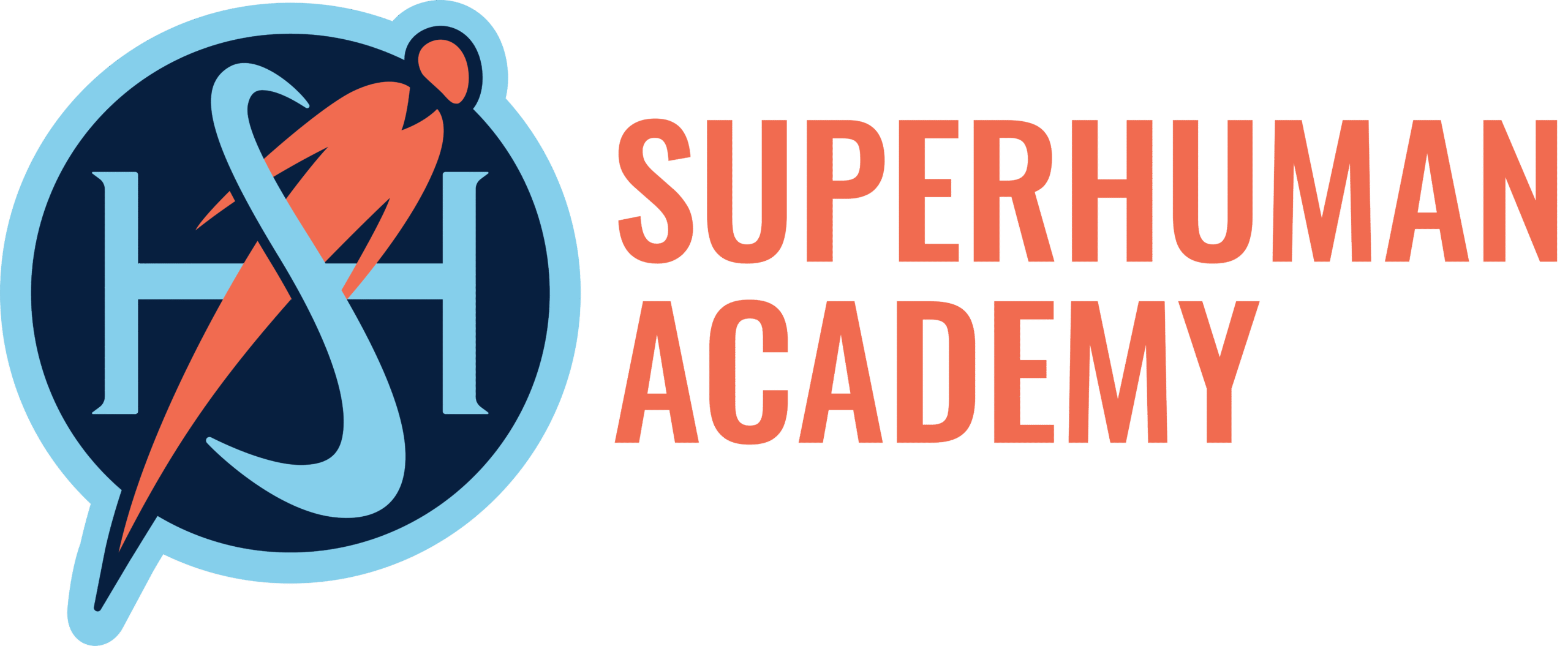
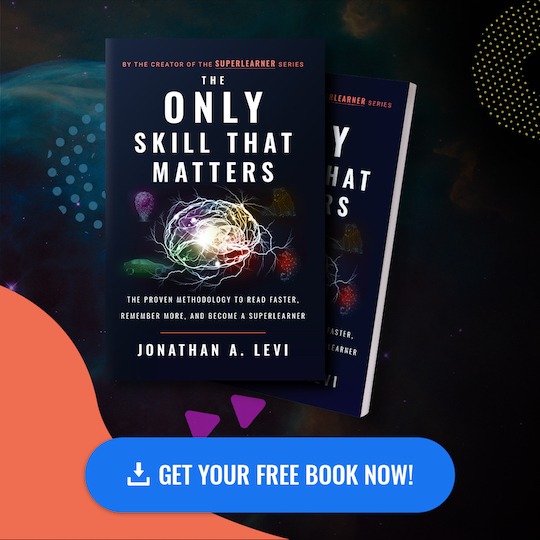




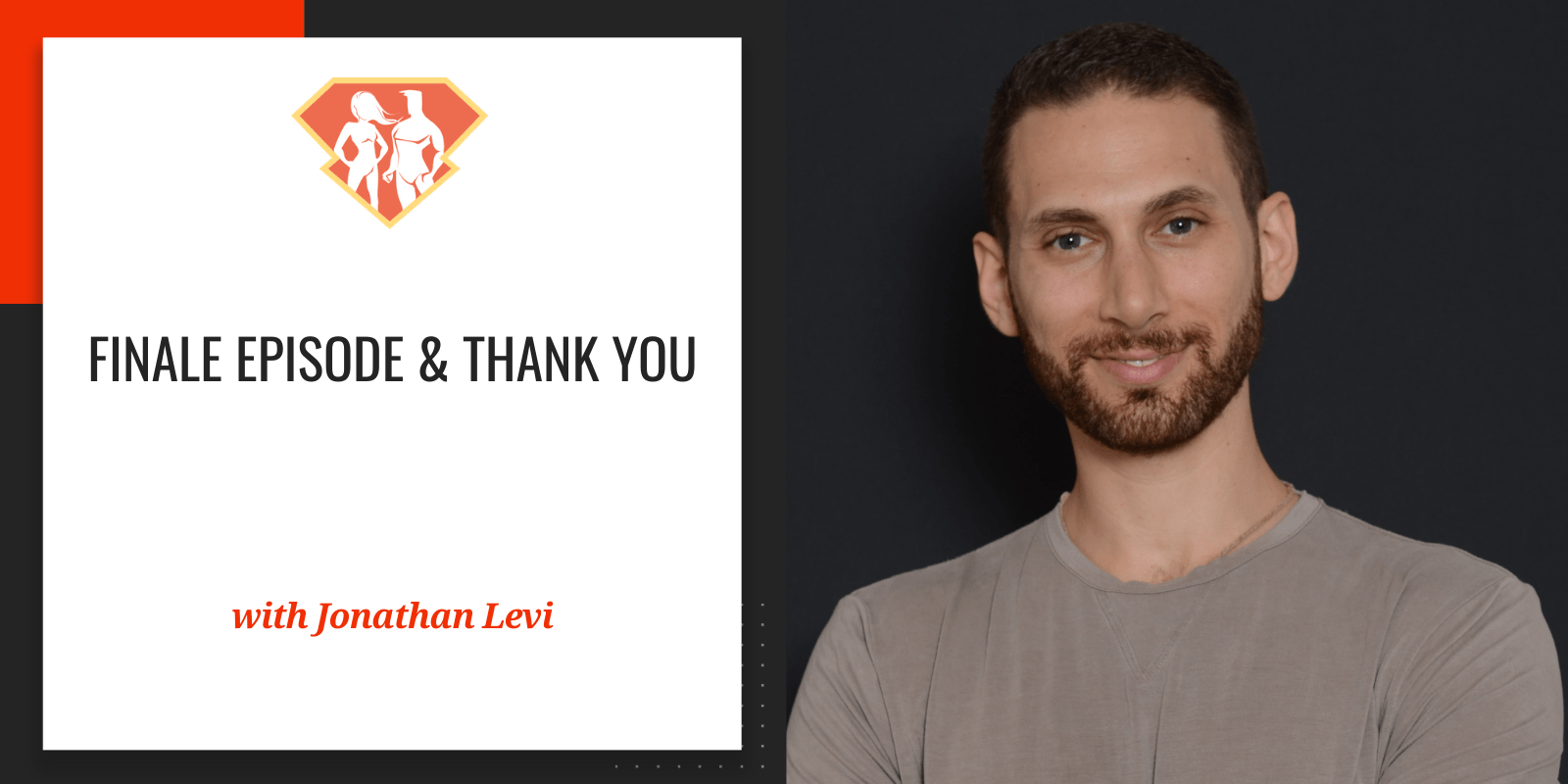
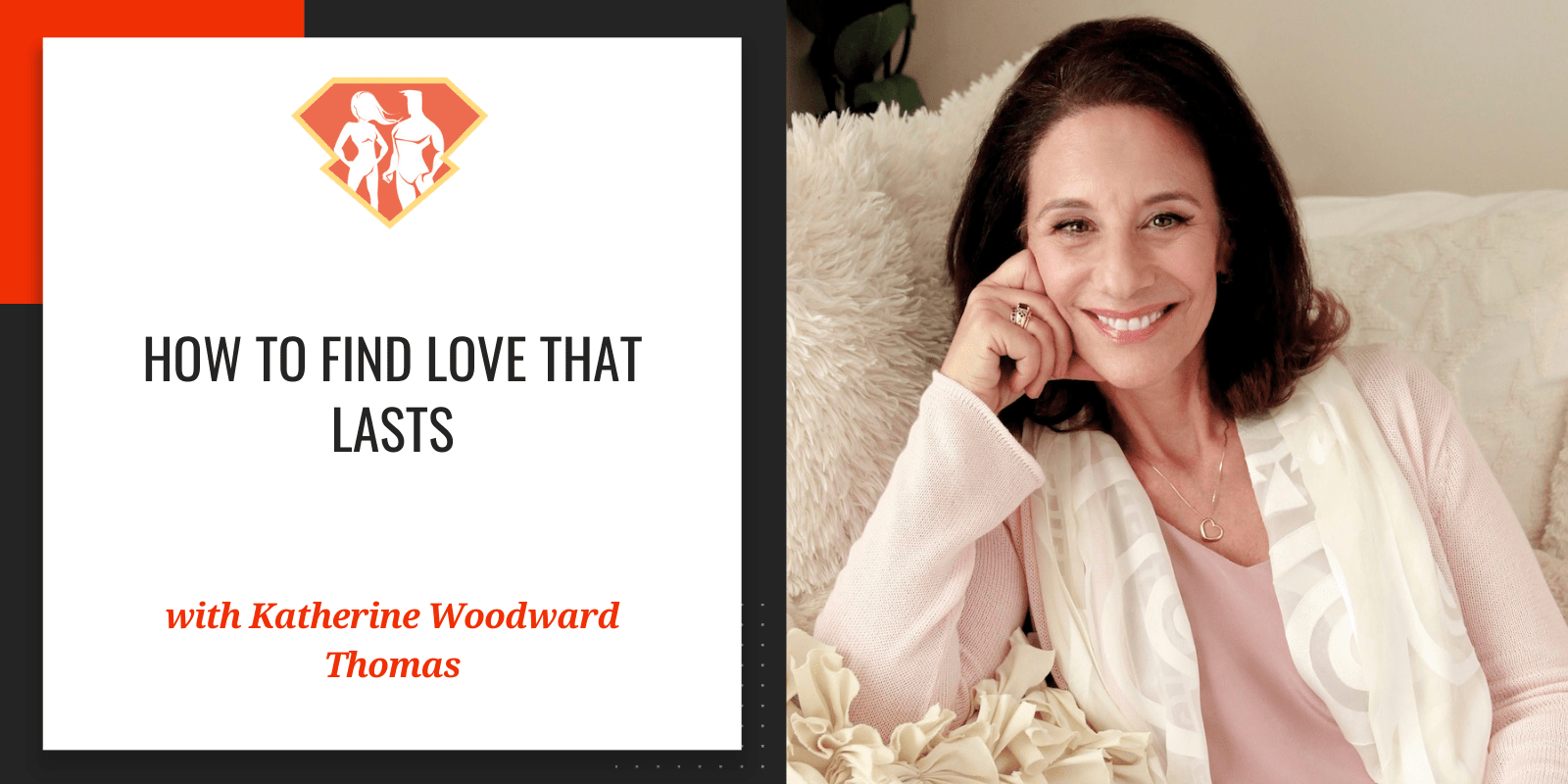
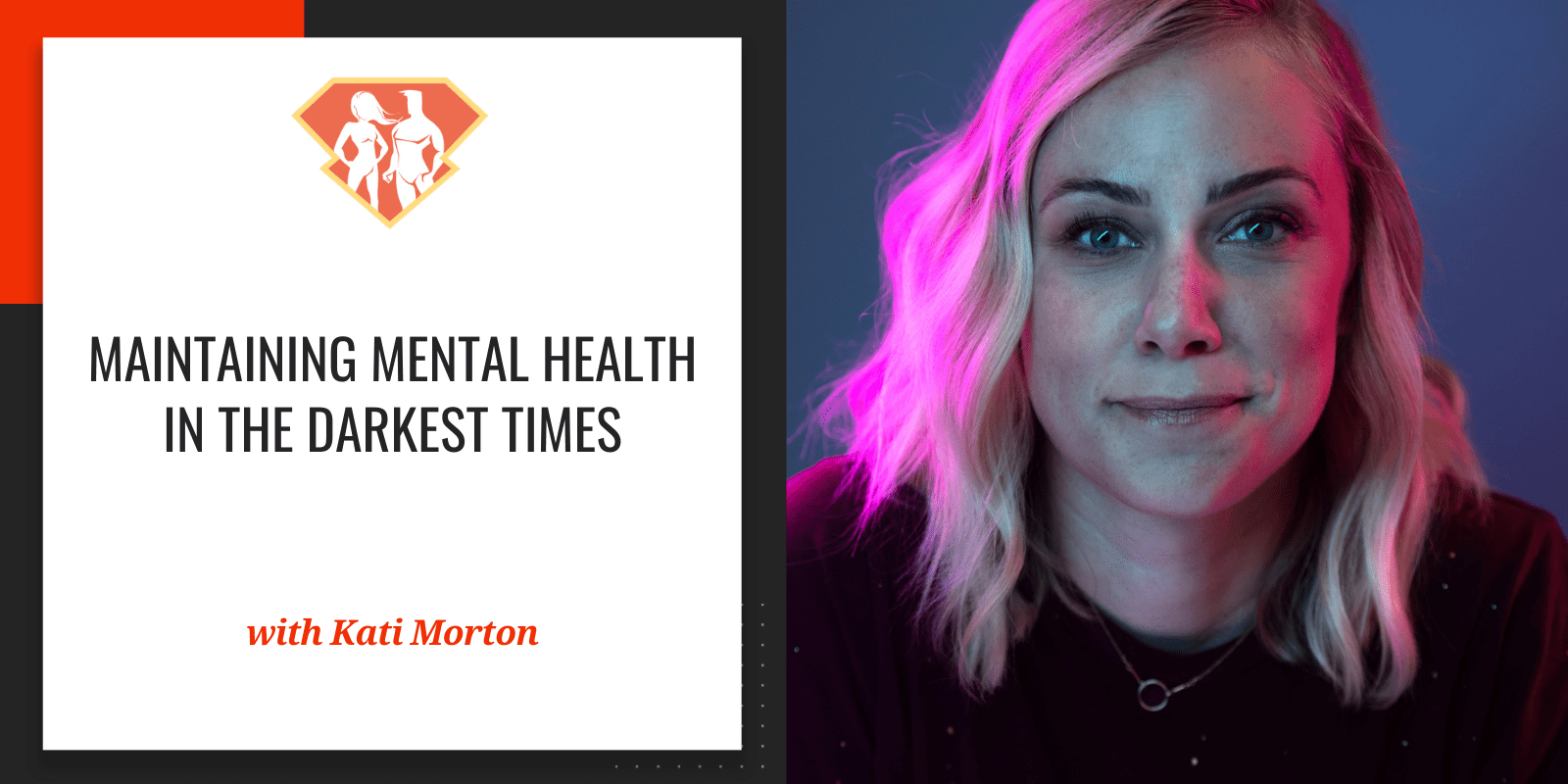

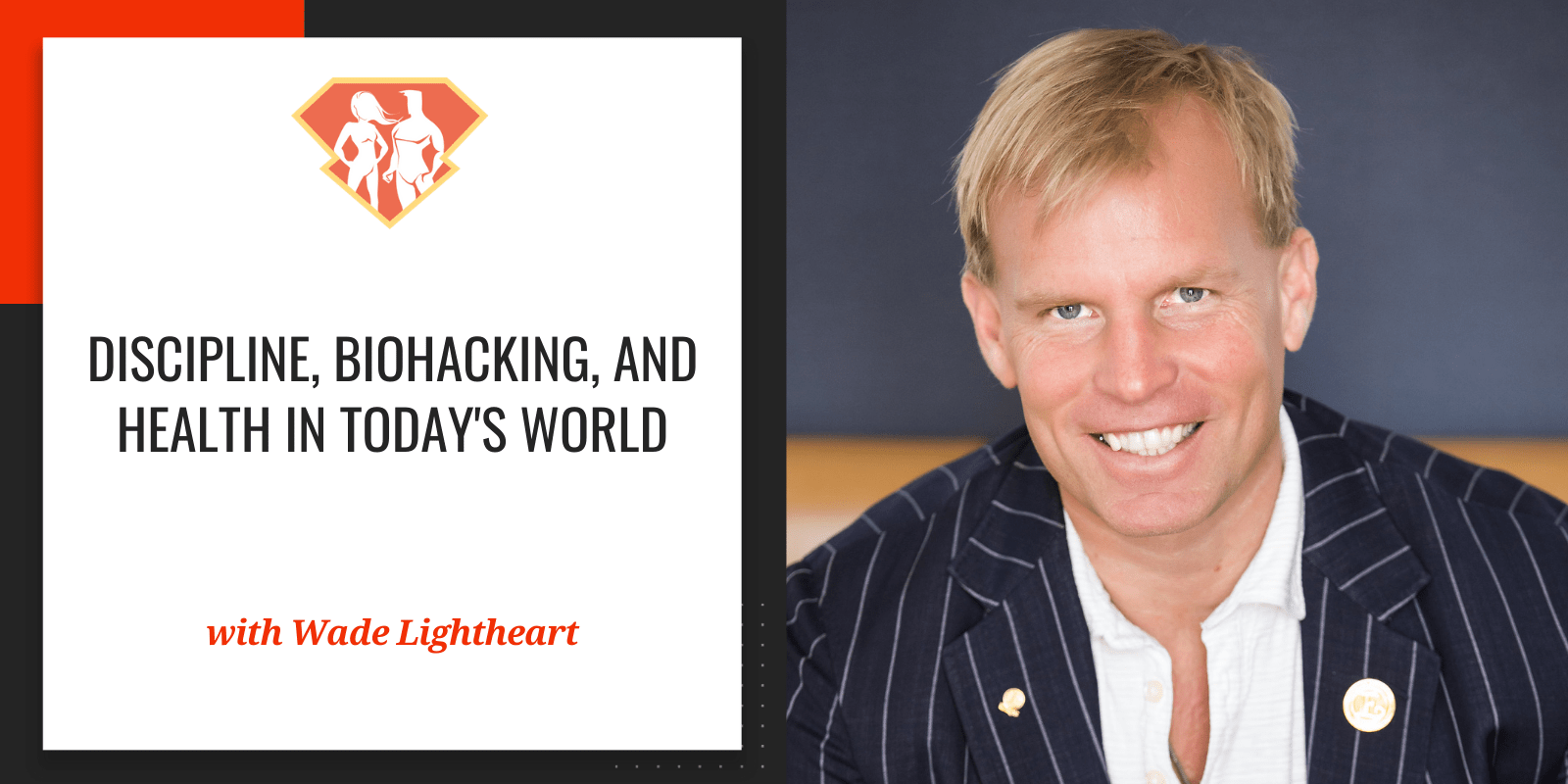
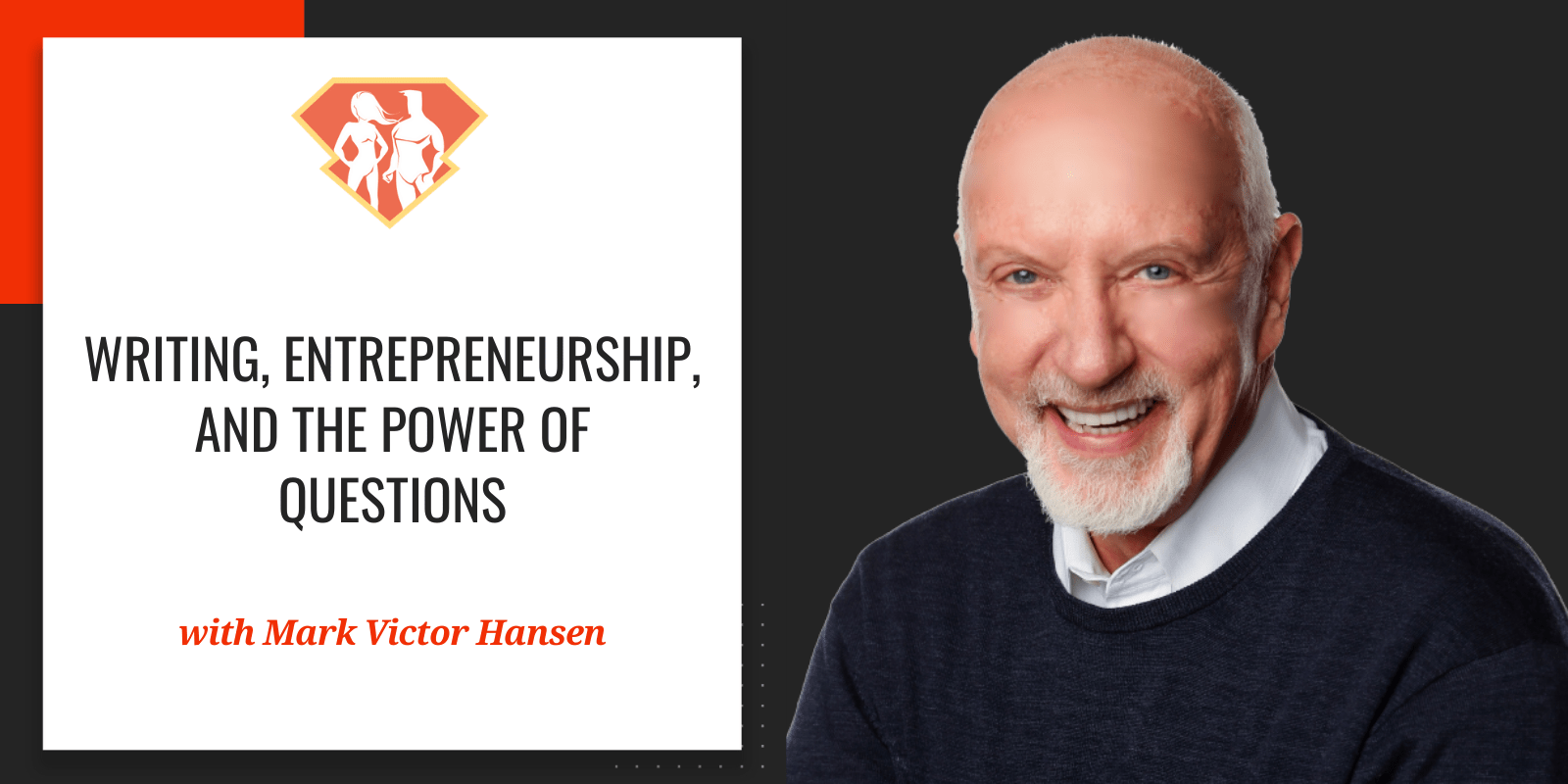
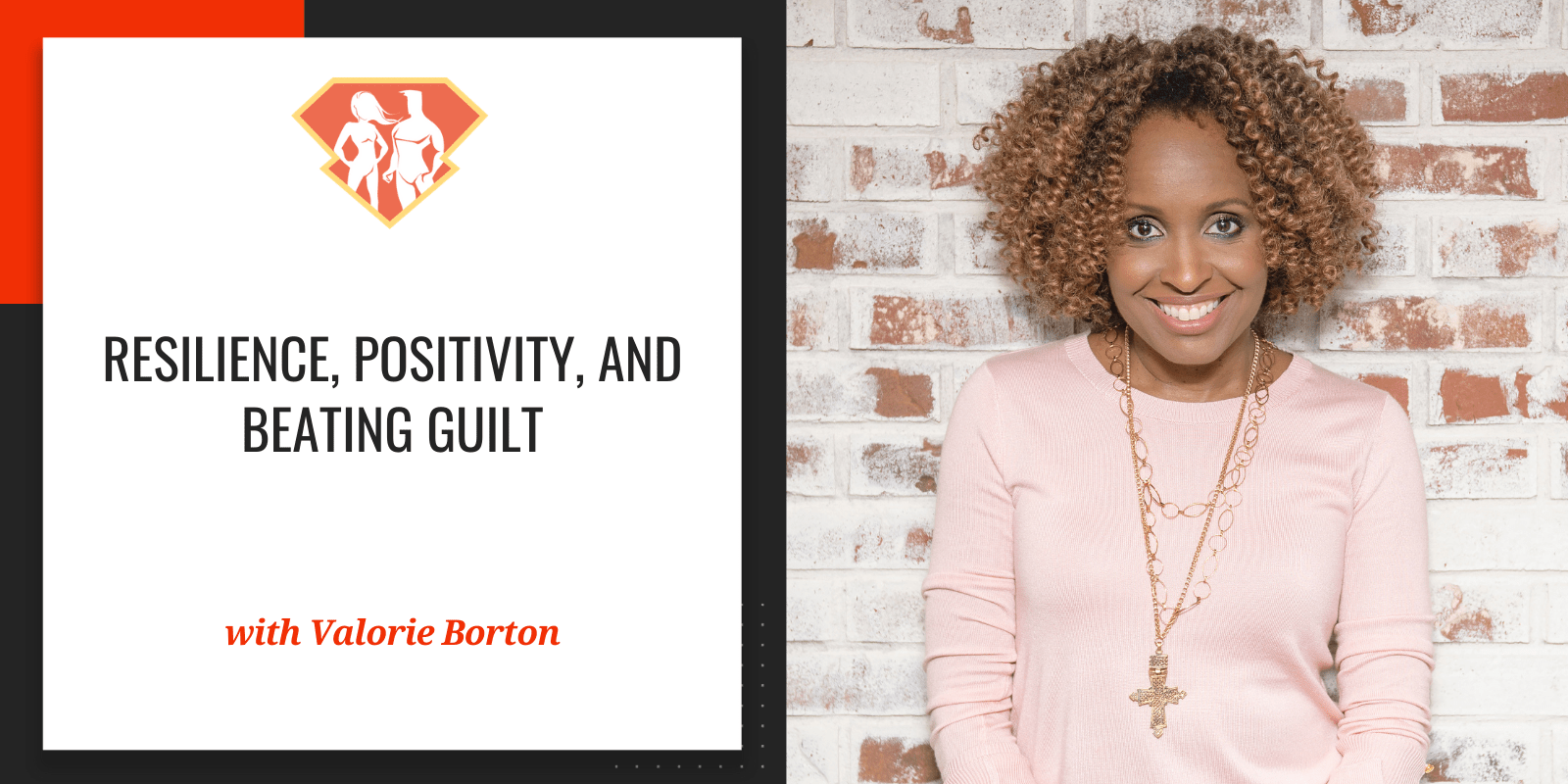
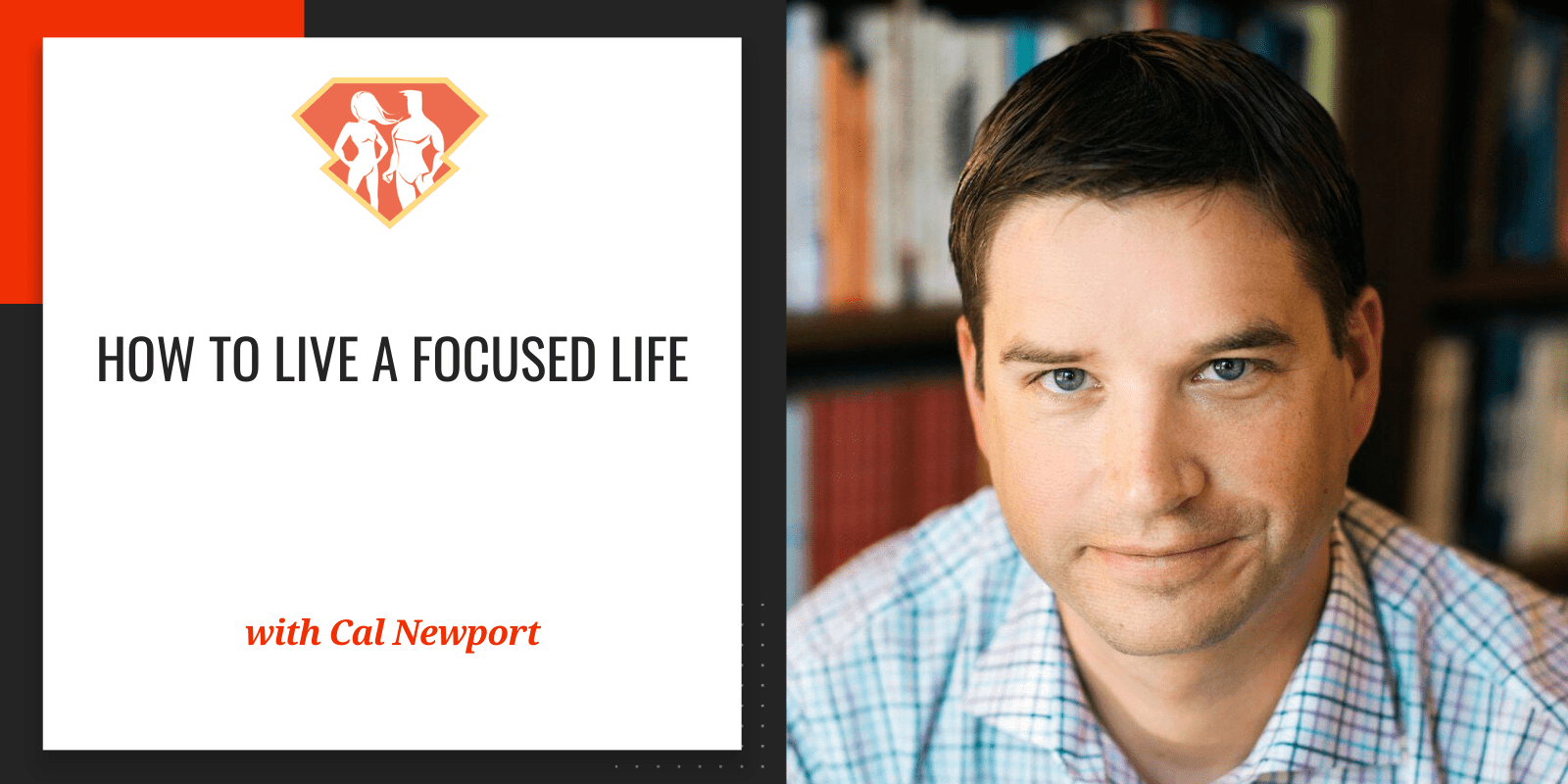
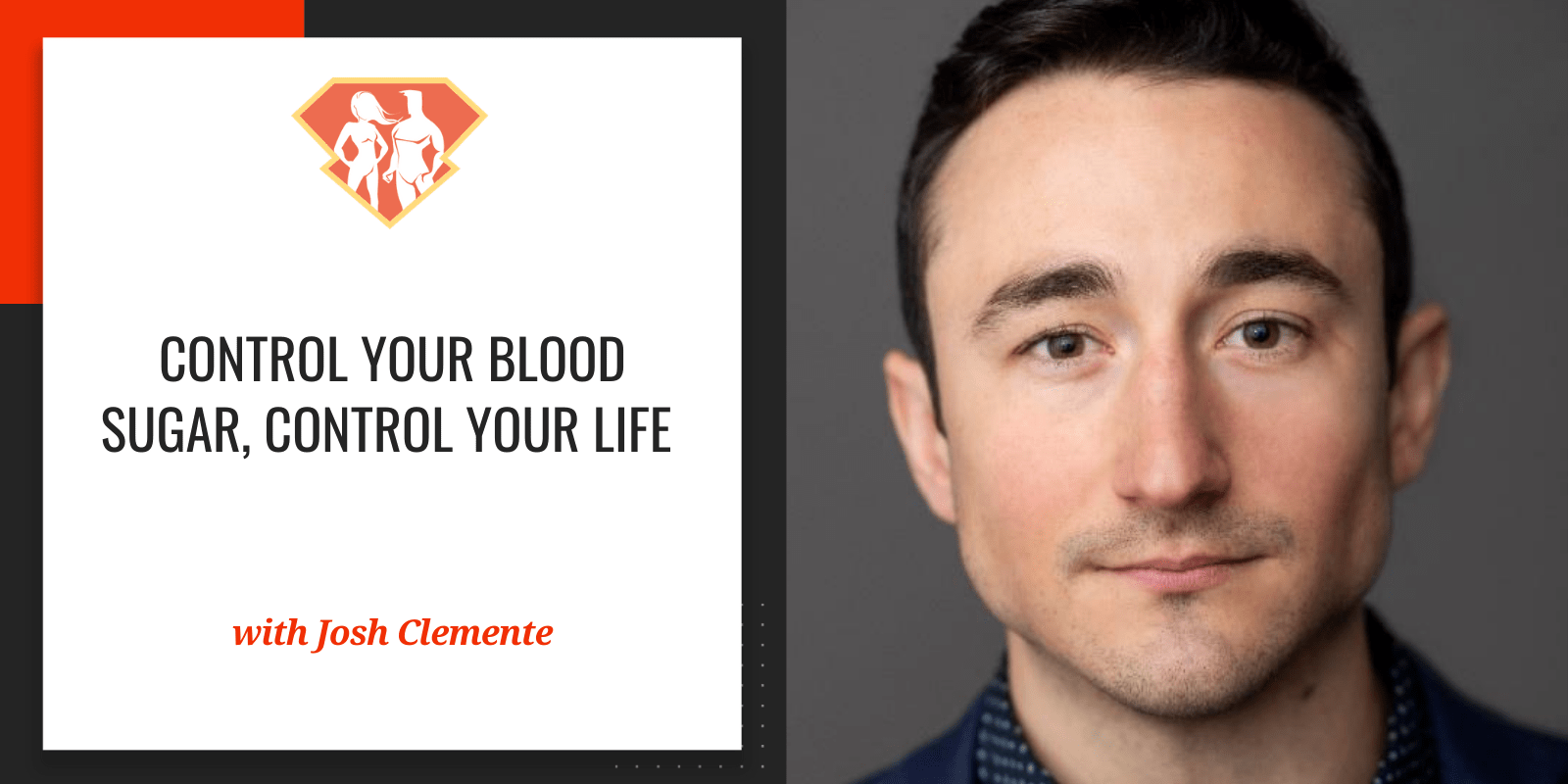
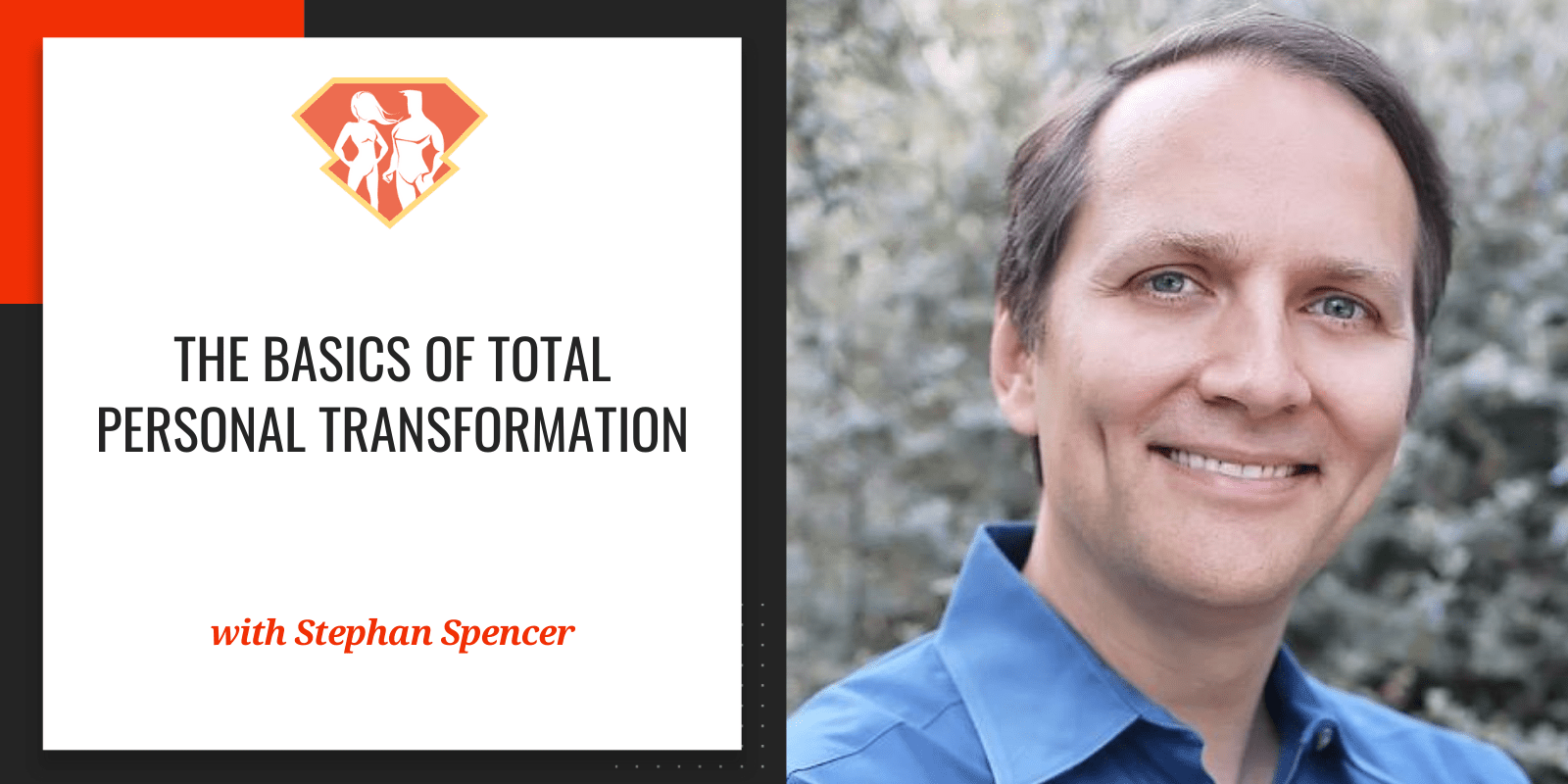
4 Comments
Thanks, I learned a lot of interesting things in past episodes.
loved th heart and the depth of the conversation. The way that Dr. Metivier shared from his enormous experience and insights was just amazing. Thank you Jonathan for doing this podcast!! 🙂
Great interview with Dr. Greg Wells! He mentioned a doctor from Colorado around the 42:30 point of the podcast, discussing turmeric and black pepper. I couldn’t make out the doctor’s name. Can you provide me with his full name and maybe his website or contact info. Interested in his products.
Thanks,
Rob
I am new here, and learning really fast.
Thank you.